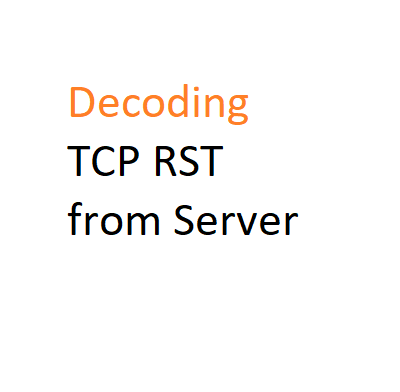Intro :
tcp-rst-from-server – TCP RST” (Reset) / is a control message in the TCP (Transmission Control Protocol) used to reset a TCP connection. It’s sent by one party to terminate a connection abruptly or to indicate an error condition. The phrase “tcp-rst-from-server” could refer to a situation where a server sends a TCP RST packet to terminate a connection with a client.
Here’s a brief explanation of each term:
Palo Alto Networks:
Palo Alto Networks is a cybersecurity company that provides various security solutions, including next-generation firewalls, network security, and cloud security.
Incomplete:
In network monitoring, “incomplete” typically refers to network connections that were not fully established or completed for some reason. This could indicate issues with connectivity or misconfigurations.
Not-Applicable :
This term might be used to indicate that a certain rule or action does not apply to a specific network connection or scenario.
Unknown-tcp/udp :
“Unknown TCP/UDP” likely refers to network traffic that the monitoring system couldn’t identify the protocol for. It could be due to encrypted traffic or unrecognized protocols.
Insufficient Data :
This term indicates that there is not enough information or data available to make a definitive assessment or decision regarding a network connection.
tcp-rst-from-client :
This indicates that the client (usually initiating the connection) sent a TCP RST (Reset) packet to terminate the connection abruptly. This could be due to an application-level error or some other issue.
tcp-rst-from-server :
This indicates that the server sent a TCP RST (Reset) packet to terminate the connection with the client abruptly. This could happen due to various reasons, including security policies, resource constraints, or application errors.
TCP RST from Server: Understanding its Significance and Implications
The Significance of TCP RST from Server:
The occurrence of a TCP RST from Server can signify various underlying scenarios, each carrying its own significance:
Resource Limitations :
In some cases, a server might send a TCP RST packet due to resource limitations. This could occur if the server is overwhelmed with incoming connection requests or if it has reached a predetermined threshold for concurrent connections.
Security Measures :
Servers equipped with advanced security mechanisms might employ TCP RST packets to sever connections that are deemed suspicious or potentially malicious. This could be part of a proactive approach to safeguard against unauthorized access or cyberattacks.
Application Errors :
An application running on the server could encounter an error that prompts the server to initiate a connection reset. This could happen if the application detects data corruption, an invalid request, or an internal error that necessitates termination.
Policy Enforcement :
Servers often adhere to certain policies, such as session duration limits or bandwidth restrictions. When these policies are violated, the server might respond with a TCP RST packet to enforce the established rules.
Traffic Management :
In scenarios where a server is managing a high volume of traffic, it may selectively terminate connections to allocate resources to more critical or legitimate connections.
Implications for Network Analysis and Troubleshooting:
The presence of tcp-rst-from-server packets in network logs can provide valuable insights for analysis and troubleshooting:
Anomalies Detection :
Network administrators and security analysts can monitor TCP RST occurrences as potential indicators of irregular activities. A sudden surge in TCP RST packets could suggest a potential security breach or a misconfigured application.
Performance Optimization :
By analyzing patterns of TCP RST packets, network engineers can identify and rectify inefficiencies, ensuring smoother data flows and improved user experiences.
Error Isolation : In the event of a connection failure, identifying whether the TCP RST originated from the server or the client can aid in isolating the source of the problem. This information can expedite the troubleshooting process.
Policy Validation :
Monitoring TCP RST occurrences helps verify the effectiveness of security policies and resource management strategies. Adjustments can be made based on real-world data to enhance network security and performance.
The Significance of TCP RST from Server:
The occurrence of a tcp-rst-from-server from Server can signify various underlying scenarios, each carrying its own significance:
| Scenario | Description |
| Resource Limitations | Server sends a TCP RST due to overwhelming connection requests or reaching a threshold for concurrent connections. |
| Security Measures | TCP RST issued to terminate suspicious or potentially malicious connections as part of advanced security measures. |
| Application Errors | An application error prompts the server to initiate a connection reset, typically due to data corruption or errors. |
| Policy Enforcement | TCP RST sent when connection violates server policies, such as session duration limits or bandwidth restrictions. |
| Traffic Management | Server terminates certain connections to allocate resources for more critical traffic during high volume scenarios. |
Implications for Network Analysis and Troubleshooting:
The presence of tcp-rst-from-server packets in network logs can provide valuable insights for analysis and troubleshooting:
| Implication | Benefits |
| Anomaly Detection | Monitoring TCP RST occurrences aids in identifying irregular activities, potentially breaches. |
| Performance Optimization | Analyzing patterns optimizes data flows, enhancing user experiences by rectifying inefficiencies. |
| Error Isolation | Distinguishing source (server or client) of TCP RST helps swiftly isolate and address issues. |
| Policy Validation | TCP RST monitoring verifies security policies, aids in adjustments for improved network security. |
Conclusion:
The TCP RST from Server phenomenon embodies the intricate dance of communication and control within the digital realm. As networks continue to evolve and security concerns escalate, the ability to interpret and respond to TCP RST packets becomes paramount. Whether stemming from resource limitations, security protocols, or application errors, the TCP RST from Server serves as a decisive message that shapes the dynamics of data exchange. By comprehending its significance and implications, network professionals can navigate the labyrinthine landscape of modern networking with heightened precision and efficacy. The world of TCP RST from Server is one that demands attention and understanding, enabling networks to thrive in an ever-changing digital landscape.
